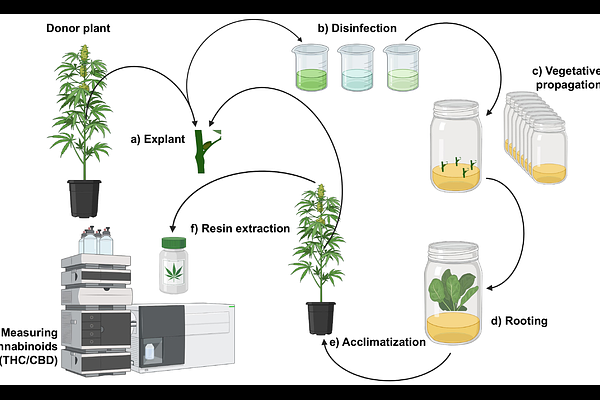Optimization of a Cannabis sativa micropropagation protocol (chemotype III) to preserve its cannabinoid profile

Optimization of a Cannabis sativa micropropagation protocol (chemotype III) to preserve its cannabinoid profile
Gonzalez, M.; Yaniuk, G.; Sannazzaro, A.; Butassi, E.; Di Liberto, M.; Perez, E.; Hourcade, M.; Svetaz, L.; Clemente, M.
AbstractA micropropagation protocol was developed using axillary buds of the Charlies Dream variety of Cannabis sativa (chemotype III, THC[lt]CBD), under the hypothesis that clonal propagation preserves the CBD[Delta]9-THC profile between donor and micropropagated plants. The effects of plant growth regulators BAP and TDZ (0.5, 1, 2.5 [mu]M) in MS medium with or without vitamin supplementation (MS vs. MSS) were determined. The progress in the growth of the axillary buds was evaluated by analyzing the shoot length, the number of shoots per explant, and the foliar area of the shoots. The role of naphthaleneacetic acid (NAA) and indolebutyric acid (IBA) in the rooting process was also evaluated in vitro and ex vitro. Resins were extracted from dried flowers of donor and micropropagated plants using cold ethanol treatment. The CBD and [Delta]9-THC contents were analyzed by GC/MS. The results show that vitamin supplementation in the MS medium did not improve any of the growth parameters evaluated. However, significant differences were observed when comparing TDZ and BAP. At 15 days post-initiation of micropropagation (dpim) from axillary buds, the explants treated with 0.5 and 1 [mu]M TDZ showed a greater number of shoots per explant and larger foliar area, compared to those treated with any concentration of BAP. However, by 30 dpim, explants treated with BAP showed an improved performance, reaching shoot numbers and foliar area values similar to those observed with TDZ. It is worth mentioning that no differences were observed in the shoot length at all concentrations analyzed for both hormones. Likewise, the explants grown in 2.5 [mu]M TDZ showed greater callus production and vitrification. The effects of supplementation with the hormone gibberellin (7 [mu]M) or exposure of the shoots to red light were also evaluated. The results indicated that combining these treatments with BAP at 0.5 and 1 [mu]M significantly enhanced shoot elongation compared to combinations with TDZ at the same concentrations. On the other hand, in vitro rooting was unsuccessful. However, direct rooting in soil was observed, and root length was further enhanced when shoots were pretreated with 2.5 [mu]M IBA. The CBD/[Delta]9-THC ratio remained stable between donor and micropropagated plants, supporting the development of standardized micropropagation protocols. Our results confirm that clonal micropropagation is a reliable method to preserve cannabinoid profiles in C. sativa.